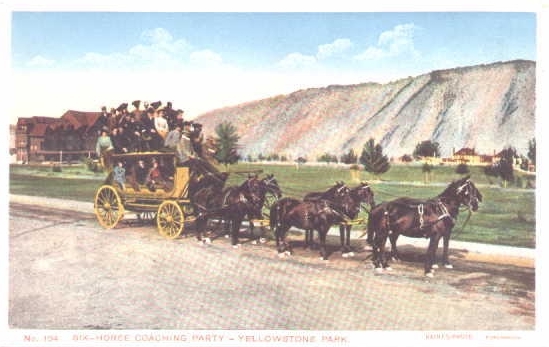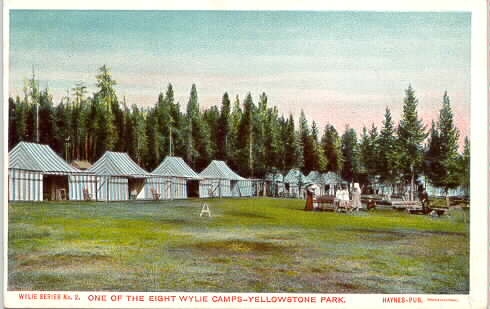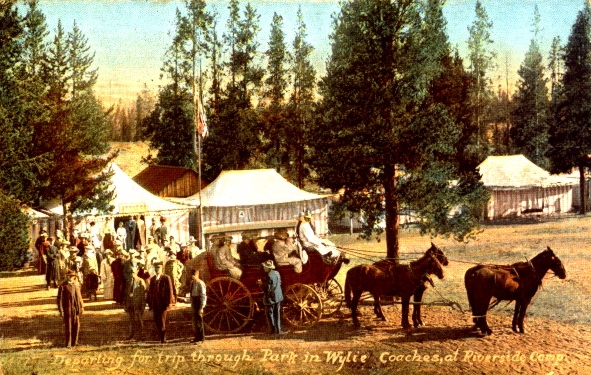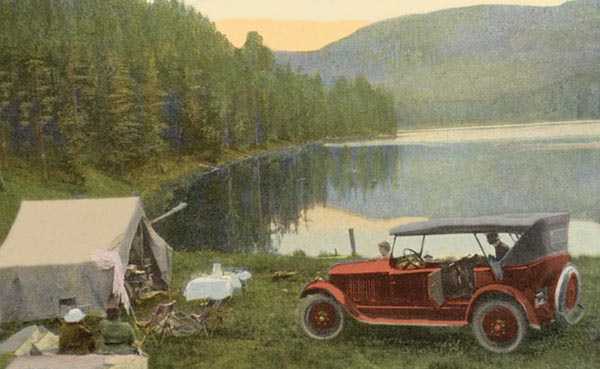
| Photos From Wyoming Tales and Trails Continued from previous page.This Page: Park Transportation, Camping Companies, Concessionaires. |
 |

| Photos From Wyoming Tales and Trails Continued from previous page.This Page: Park Transportation, Camping Companies, Concessionaires. |
 |
|
|
|
About This Site |
 Yellowstone Stage, prior to 1916, photo by Haynes
 Wylie Campgound, photo by F. J. Haynes Wylie operated campgrounds at Swan Lake flats, Riverside, Upper Guyser Basin, Fishing Bridge, Canyon, Sylvan Pass and Tower Falls. View of Riverside Camp below.
 Stage Leaving Riverside Camp Note the dusters on the passengers. The stages on the tours would normally stay 500 feet apart to keep down the dust.
Each of the campgrounds, in addition to the tents for sleeping accommodations, see photo to right, included dining, restroom and bathing facilities. Visitors were transported thorugh the park by stage and would spend each night in a different facility. On one occasion, the stage trip included an extra adventure. In 1914, a line of 15 stages was stopped by a stage robber and 82 passengers were relieved of $915.35 and approximately $300 in jewelry. The robber apparently did not notice that three of the tourists were taking photos and one was make a sketch. As a result Edward Trafton spent the next five years in Leavenworth. The following year, official park phtographer, Frank Jay Haynes, thwarted an attempted robbery of the coaches. The same year, 1915, was the first year automobiles were officially permitted in the park, thus causing competition between the cars and the horse-drawn stages. As noted on the previous pages, the stages were eliminated the following season in 1916.
In 1917, the two camping companies were required to merge, forming the Yellowstone Park Camping Company which continued to operate camping facilities for tourists who did not wish to utilize the more expensive hotels. Additionally, hotel operations were consolidated and Frank Jay Haynes who previous owned several hotels was required to give up the hotels, but continued in his photography business. As of 2002, the oldest concessionaire in the Park is Hamilton Stores. It received its start in 1915, when Charles A. Hamilton purchased the Klamer general store at Old Faithful for $5,000. He did not have sufficient funds in the bank to cover the check. Thus, he quickly borrowed the money and rode all night to the bank to deposit the funds before the check hit the bank. In 2002, the National Park Service announced that the Hamilton concession would be cancelled as of December 31, 2002. The first official concession was the designation of Haynes as the official photographer for the park in the 1880's. Upon the death of Jack Haynes, Hamilton Stores purchased the Haynes interests.
In one sense, however, the history of concessions in the park dates back to prior to the actual formation of the park. In 1871, James C. McCartney and Harry Horr constructed a hotel at Mamouth Hot Springs. It was not much of a hotel, but was regarded as the last outpost of civilization in the sense that it was the last place where one could obtain alcohol. Stage tours of the park date to 1881, when Marshall and Goff Stagelines becane offering tours. However, until the arrival of the railroad in 1906, the Park was difficult to get to. Territorial Governor John Hoyt in his official reports several times noted the necessity of building roads to the park. Not withstanding the arrival of cars in 1915, the roads in the park were not paved until the 1930's. They still, however, follow the "Grand Loop" pattern laid out by Park Engineer Chittenden during his term.  Sylvan Lake, 1927 Next page: Laramie
|

